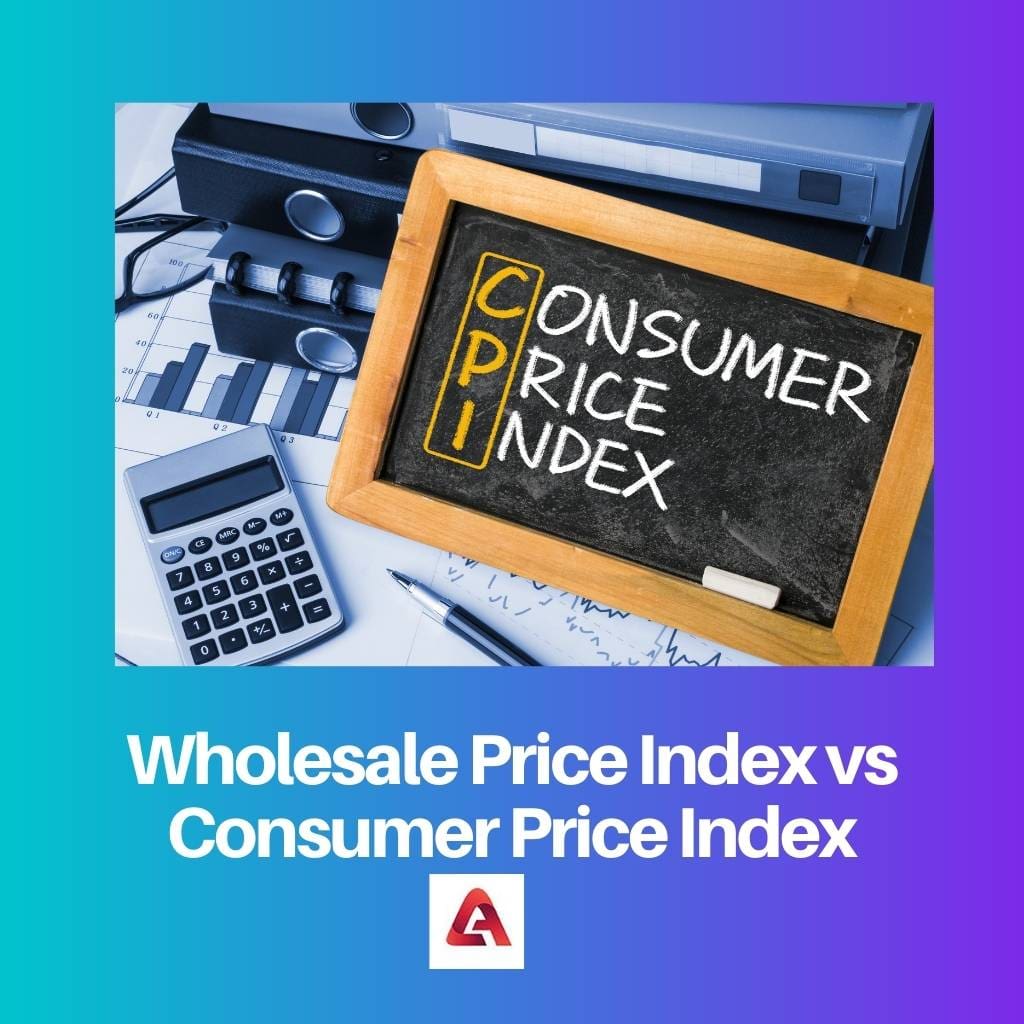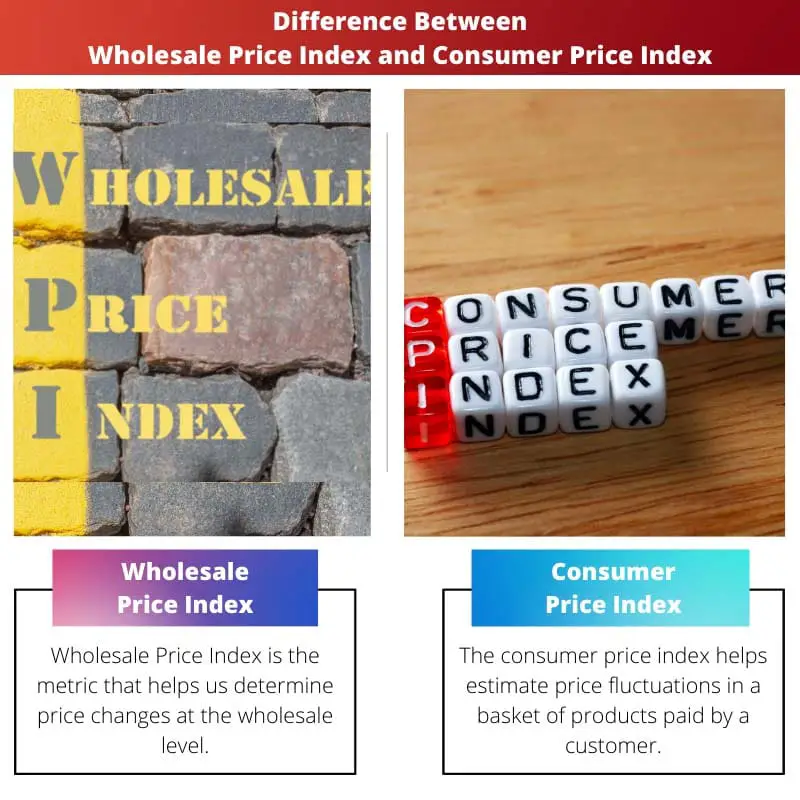Inflation is the change in the prices of goods and commodities at a specified level. Inflation is measured by two units: Wholesale Price Index and Consumer Price Index.
The Wholesale Price Index is a price indicator that is used to determine price changes in the market for items offered wholesale. Another price index that focuses on the amount of money that a customer must pay is the Consumer Price Index.
Key Takeaways
- Wholesale Price Index (WPI) measures wholesale businesses’ average price change of goods sold in bulk.
- The consumer Price Index (CPI) measures the average change in household goods and services prices.
- While both indices provide useful information about price trends, they are based on different types of goods and have different economic implications.
Wholesale Price Index vs Consumer Price Index
The Wholesale Price Index (WPI) is a measure of the average change in the prices of goods that are sold in bulk by wholesalers. The Consumer Price Index (CPI) measures the average change in the prices of goods and services that are purchased by households, reflecting consumers’ cost of living.

The Wholesale Pricing Index (WPI) is a gauge of wholesale price fluctuations. It tracks the market price paid by manufacturers and distributors.
It is a price index that helps us know the prices of goods at several levels before reaching the sale level. WPI is the very first level where price changes are determined.
The Consumer Price Index (CPI) is a valuation method that reflects the overall cost of goods under a certain time period. It estimates the average price paid by customers to merchants.
It is considered a better method as it is used to determine the price paid by a customer for a particular basket of goods.
Comparison Table
| Parameters of Comparison | Wholesale Price Index | Consumer Price Index |
|---|---|---|
| Definition | Wholesale Price Index is the metric that helps us determine price changes at the wholesale level. | The consumer price index helps estimate price fluctuations in a basket of products paid by a customer. |
| Published by | It is issued by the Ministry of Commerce and Industry’s Office of Economic Advisor. | The Central Statistics Office of the Ministry of Statistics and Programme Implementation publishes the Consumer price index. |
| Measurement of Inflation | Inflation is measured at the first stage by the Whole Price Index. | Inflation is measured at the final stage by the Consumer Price Index |
| Covered Goods and Services | Food articles, non-food articles, and minerals are the main articles used to calculate Wholesale Price Index. | Food, energy services, electricity, vehicles are the main articles used to calculate the inflation in Consumer Price Index. |
| Used by Countries | Only a few nations, primarily emerging countries with strong manufacturing industries utilize the Wholesale Price Index. | Consumer Price Index has been widely utilized by over a hundred countries. |
What is Wholesale Price Index (WPI)?
WPI stands for Wholesale Price Index, and it is used to calculate the average change in price when a wholesaler sells items in large quantities.
Before reaching the final level, WPI estimates the price at a certain level. Usually, WPI is determined at the initial level.
WPI is published monthly to show average price changes in products. The total cost of commodities this year is compared to that of the previous year.
Prices from the previous year are compared to the total, and the difference is reported as a percentage. The base year taken in WPI is 2011-2012.
WPI is issued by the Ministry of Commerce and Industry’s Office of Economic Advisor. It is used only for the goods alone. The total goods covered in WPI are around 696 items.
It tracks the market price paid by manufacturers and distributors. It is a price index that helps us know the prices of goods at several levels before reaching the sale level. WPI is the very first level where price changes are determined.
Only a few nations, primarily emerging countries with strong manufacturing industries, utilize the Wholesale Price Index.

What is Consumer Price Index (CPI )?
The CPI is a consumer price index that monitors the change in the price of a particular basket of goods that a consumer pays for.
The consumer price index is the change in prices of goods in the final stage. For a particular year, the Consumer Price Index (CPI) formula is:
The Consumer Price Index (CPI) is a suitable indicator to know where your economy lies. It is the most commonly used indicator of inflation and, by extension, of the government’s economic policy success.
CPI lets the government know about the price fluctuations each consumer brings out, helping them in making big economic decisions.
The Central Statistics Office of the Ministry of Statistics and Programme Implementation publishes the CPI. Unlike WPI, it includes both goods and services. It is published once a month.
The goods covered in CPI are divided into two parts: the urban basket of goods and the rural basket of goods.
The calendar year is used as the CPI’s base year. It plays an important role in maintaining a country’s economy as it is an essential factor to determine inflation.

Main Differences between Wholesale Price Index and Consumer Price Index
- The Wholesale Price Index and Consumer Price Index are that WPI measures the change in prices of goods at the wholesale level, whereas CPI measures the change in prices of goods at the consumer level.
- WPI is the initial level, and the CPI is the final level at which goods prices begin to fluctuate.
- WPI concentrates on items that are exclusively exchanged among wholesalers or companies, whereas CPI concentrates on items that customers purchase.
- Only a few nations use the WPI, whereas CPI is a popular concept to be used by multiple countries.
- WPI is issued by the Ministry of Commerce and Industry’s Office of Economic Advisor, whereas the Central Statistics Office of the Ministry of Statistics and Programme Implementation publishes the CPI.

- https://www.worldscientific.com/doi/abs/10.1142/S0217590810003882
- https://pdfs.semanticscholar.org/a1c3/b179b2ec60f8b24bc1624f5ccd81cae9e3d5.pdf

The explanation of the base year used in WPI for price comparison is particularly interesting, providing a deeper understanding of the index.
I agree, the article’s focus on the base year used in WPI adds an insightful dimension to understanding how the index is calculated.
The comprehensive explanation of the CPI formula and its significance in economic policy evaluation is very well-presented.
Indeed, the example of the Consumer Price Index formula helps in understanding the practical application of the CPI in real economic scenarios.
I agree, the article provides a clear understanding of how the CPI plays a role in assessing a country’s economic progress.
The analysis of the Consumer Price Index and its relevance in understanding the economy is enlightening.
Absolutely, the Consumer Price Index is a critical tool for assessing price changes and is widely used by many countries.
Understanding the roles of WPI and CPI in measuring inflation is essential to comprehend the economic condition of a nation.
Absolutely, the WPI and CPI provide valuable insight into the price changes at different stages of the economy.
The article does a great job in explaining the significance and utilization of WPI and CPI in measuring inflation.
The applications of WPI and CPI in different economic stages are explained thoroughly, providing valuable insights.
I agree, the distinction between the measurement of inflation at different stages by WPI and CPI is well-delineated in the article.
The detailed description of WPI is very informative. It’s interesting to note that only a few nations use the Wholesale Price Index.
Yes, that was an eye-opening fact. I appreciate the in-depth explanation provided in the article.
The detailed explanation of WPI and CPI, along with the comparison table, allows for a comprehensive understanding of these indices.
Absolutely, the comparison table particularly highlights the key differences in the WPI and CPI, making it easier to comprehend.
The relevance of the Consumer Price Index in evaluating economic policies is well-articulated in the article.
The article effectively outlines the significance of the Consumer Price Index in economic assessments and policy decisions.
Absolutely, the example provided about the utility of the CPI in assessing economic policy success is very informative.
The explanation about the difference between Wholesale Price Index (WPI) and Consumer Price Index (CPI) is very clear and simple to understand. Thank you for the detailed information.
I agree, the comparison table provided is especially helpful in understanding the different parameters of the two indices.